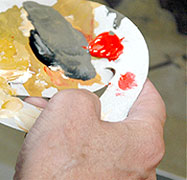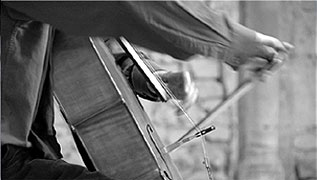Iconostasis painting
Till NewJune 2008 - June 2009

Being able to exhibit in the Wintringer Chapel is like a promise that turns into happiness. "Pèlerinage - pilgrimage with the eyes " was the title in 2005, when miniatures of my paintings could be seen on the walls of the chapel. This year, my idea focused on a large, multi-part work that will be placed in front of the apse as a picture wall. Visitors to the chapel will stop where the space once defined itself sacredly: in the place of an altar or, as in the Christian Orthodox church, in front of an iconostasis.

An iconostasis, literally a "set up image," completely separates the congregation space from the sanctuary, its three doors opening only rarely during certain rituals. Those functions, as well as the history of salvation itself, the intercessory personnel or even the martyrs on the numerous icon panels, no longer play a role in my work. "My iconostasis" tells about heaven and hell on earth and their images in art. The space of the chapel animated me to realize the long-cherished idea of a large painting. 48 individual panels are distributed on two halves. On the left, images of danger, violence and death; on the right, images of hope, joy, happiness. I feel like an eyewitness of those images in everyday life and in the history of art, to which I cannot remain silent. Continue to tell in my language, as was customary with myths.
In current art, a dying person will soon be displayed as part of a work of art, which will increase the viewers' excitement. A few years earlier, two English artists bought Francisco Goya's etching cycle "Desastres de la Guerra" (seven exist), then reworked and "improved" 80 prints. The frisson that Goya's violence-ravaged figures elicited had not been enough for them. I see in them provocative prestige forms which, with their insensitivity, degrade bodily dying people and drawn dying people to toys.
I incorporate works of other artists and cultures into my work without competing with them "linguistically." I quote frescoes by the Sienese artist Pietro Lorenzetti from the Middle Ages or paintings by Paul Gauguin. In the quotations, artistic means and convictions of the other work remain alive, even if the pictorial narrative changes.
With the diversity of image sources, a special image concept developed: 48 images perform themselves in a 20 x 20 cm small field each, which is calmed on the outside by monochrome painting. In a months-long work, my painting with the hand became a touch, accompanied by my compassion for beauty, for peaceful, for injuries, for the powerlessness of the victims, for suffering. It is not any polarity of life that interested me, but a deeper look at the precious and often cruelly extinguished existence of the small, mortal individual.
Till Neu, Saarbrücken in April 2008
The "Iconostasis" will be a guest at Schloss Dagstuhl, Leibniz Center for Informatics, in Wadern from June 2009.
Dark Side (Left Half of Iconostasis Images 1-24)
Bright side (right half of the iconostasis, images 25-48)
All pictures 20 x 20 cm, bookbinding cardboard, acrylic, tempera, created in La Lilette, January-April 2008
Short vita

Till Neu, born 1943 in Saarbrücken | Studies at the Werkkunstschule in Saarbrücken with Oskar Holweck (basics of design) | Studies at the Hochschule der Bildenden Künste in Kassel, painting with Fritz Winter | Studies in art history, doctorate on design teachings (1976), University of Saarbrücken | Since 1978 two professions: Artistic work and teaching | Since 1984 professor at the Johann Wolfgang Goethe University in Frankfurt/Main, at the Institute for Art Education, since 1993 for painting and art history | Solo exhibitions since 1969 | Publications of books, cassettes, catalogs | Premature end of teaching in April 2004, in order to be able to work more intensively artistically | Residences Saarbrücken and a village in the Vaucluse, at the foot of Mont Ventoux.





















































